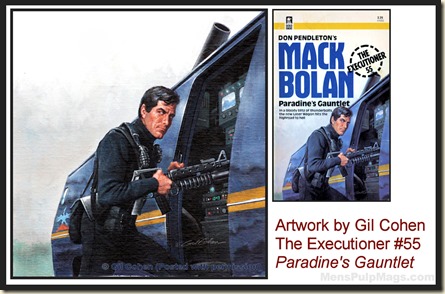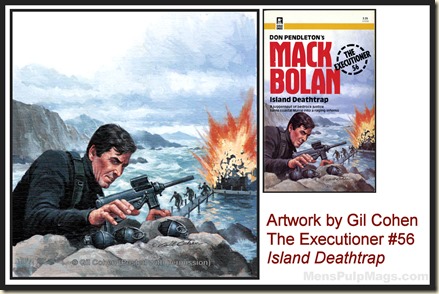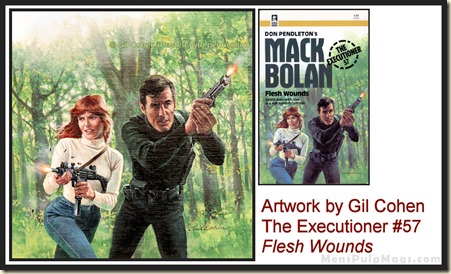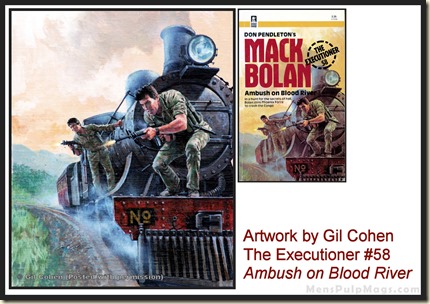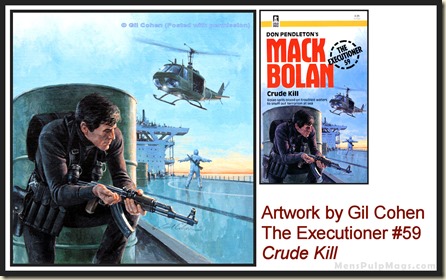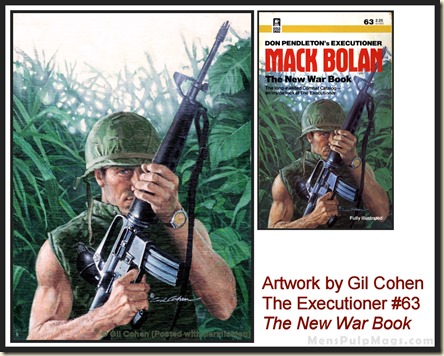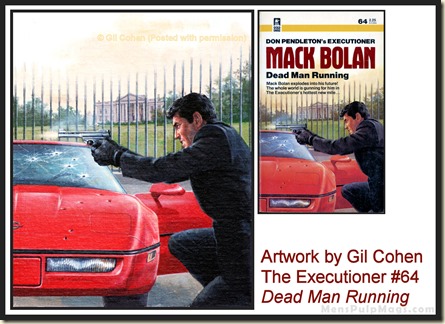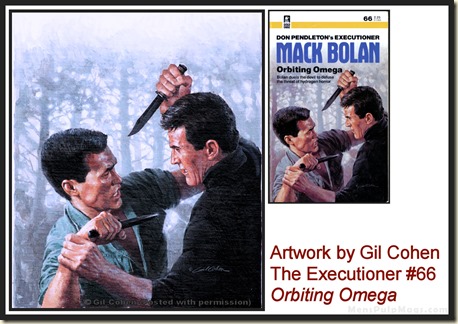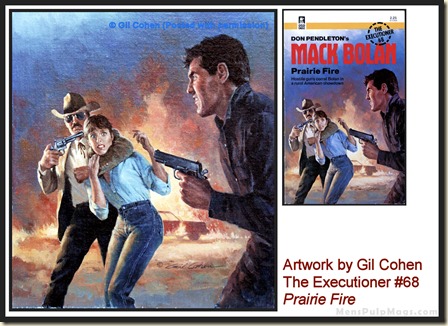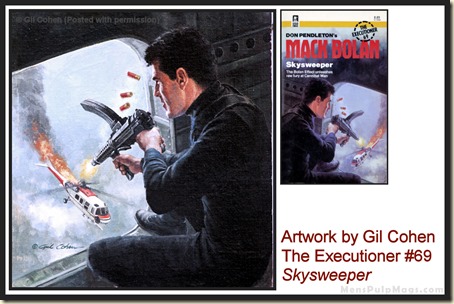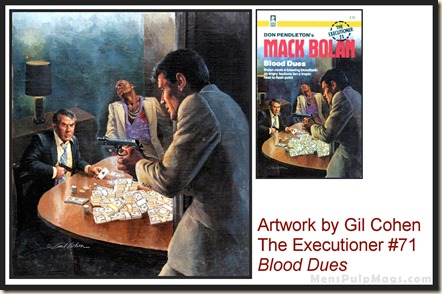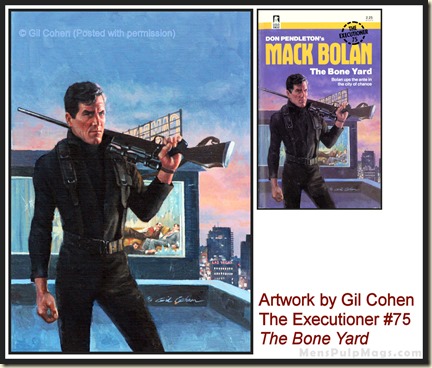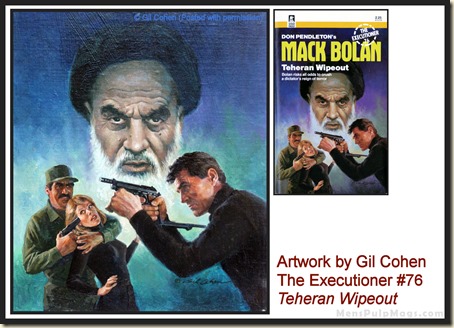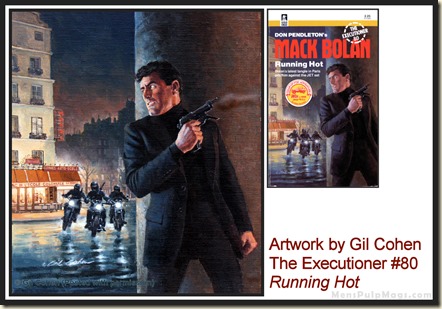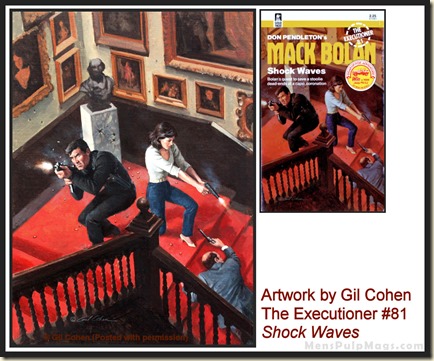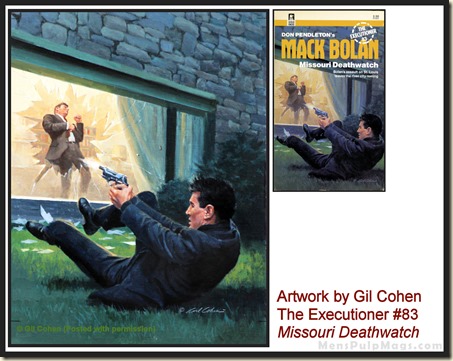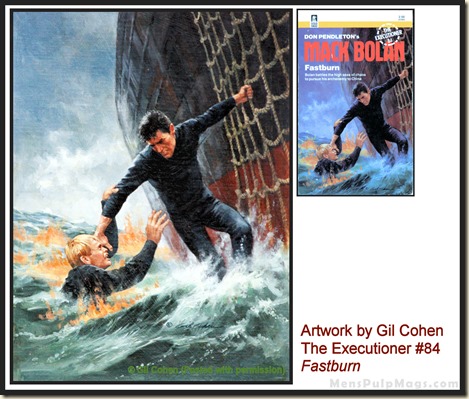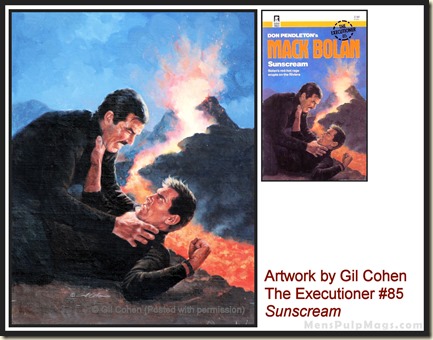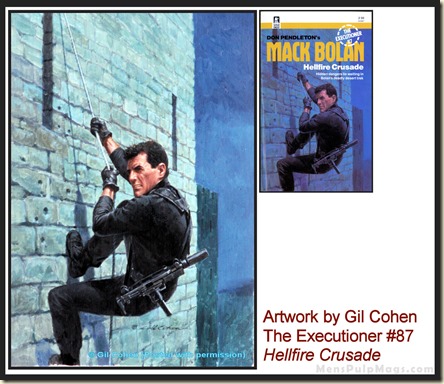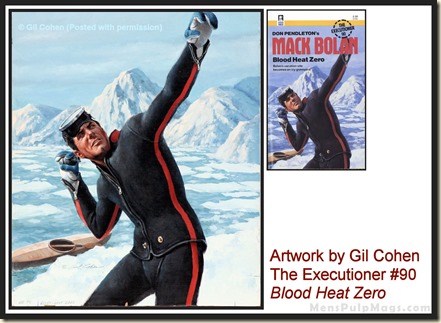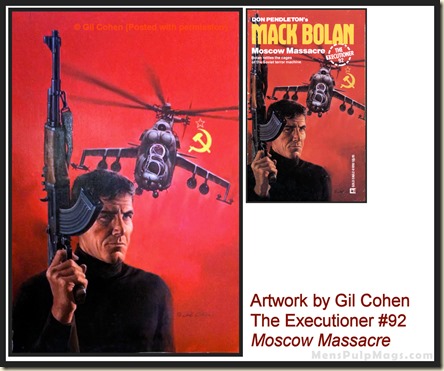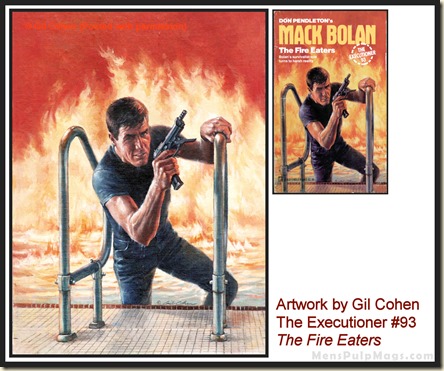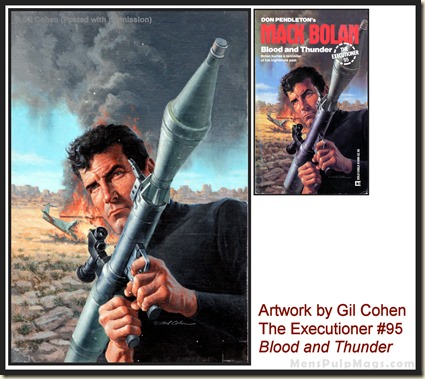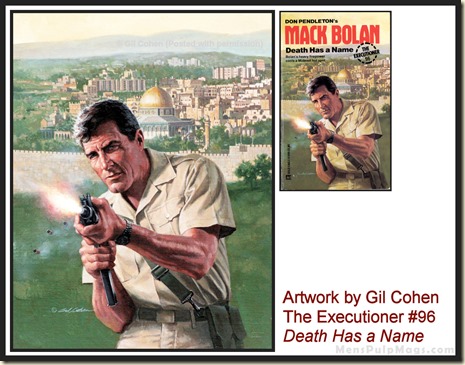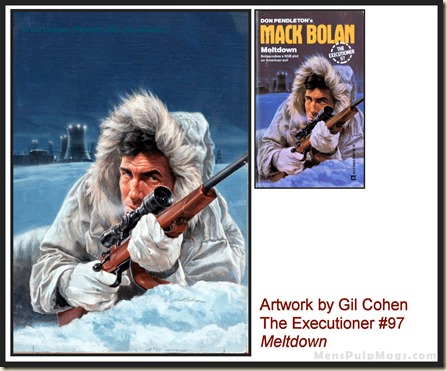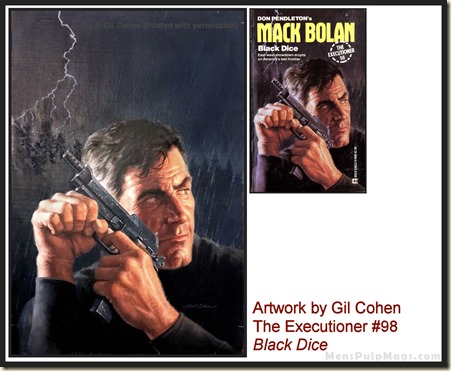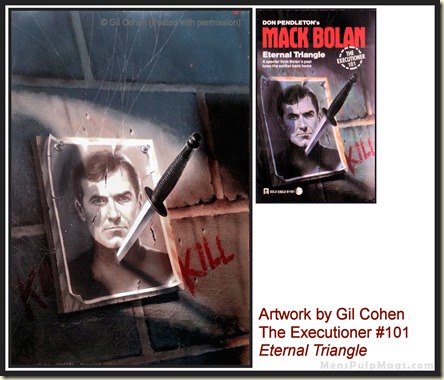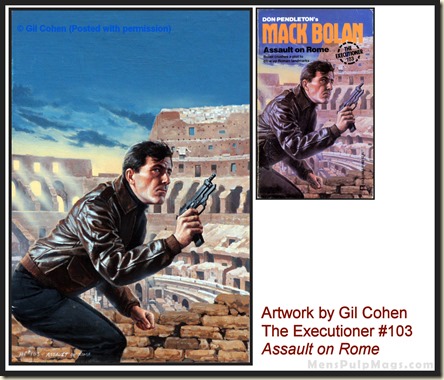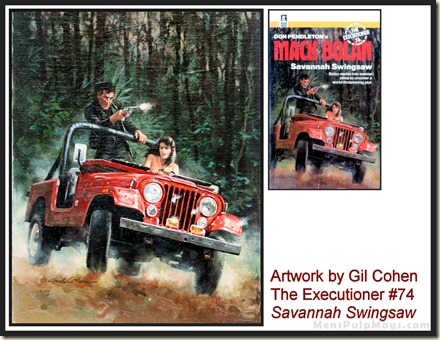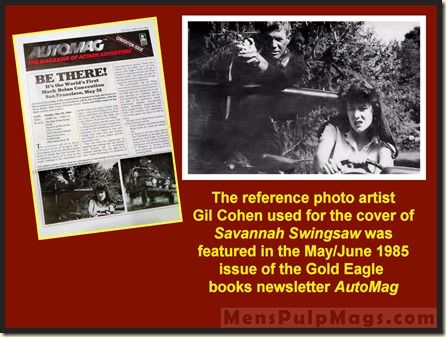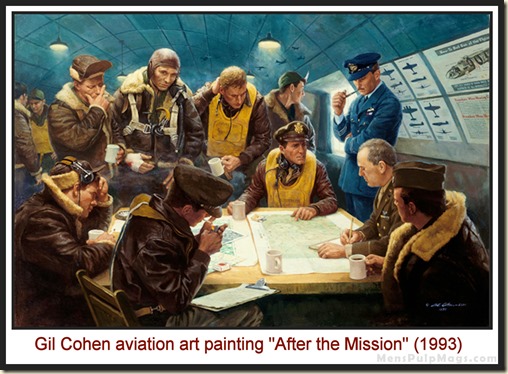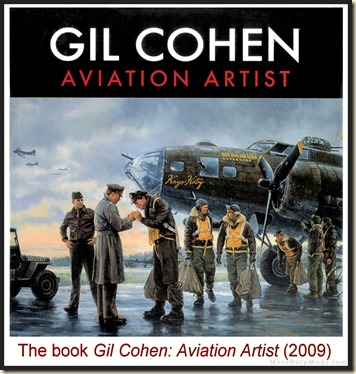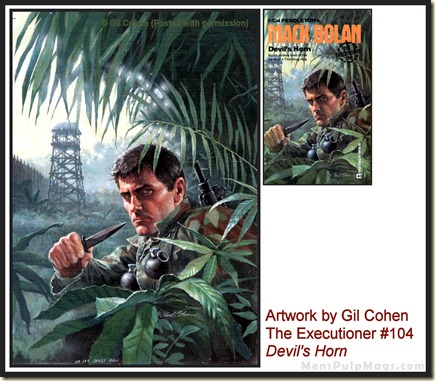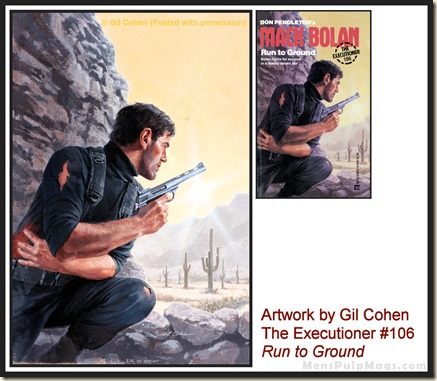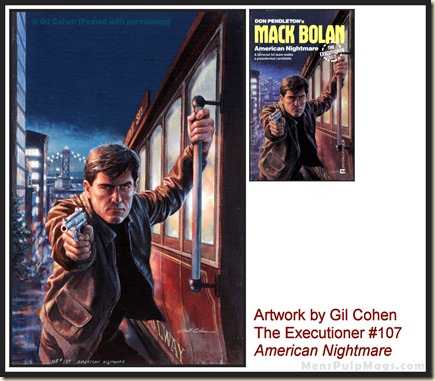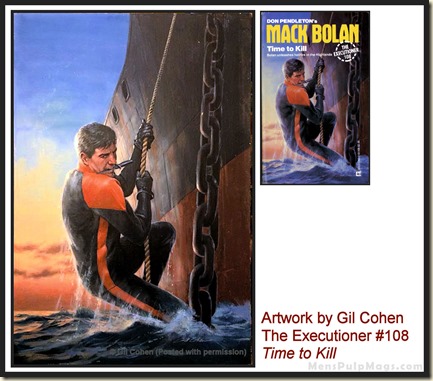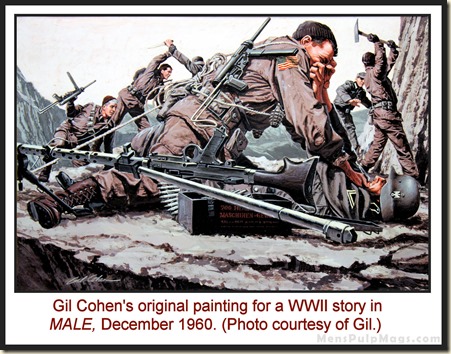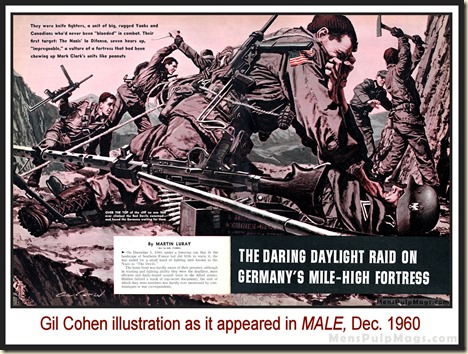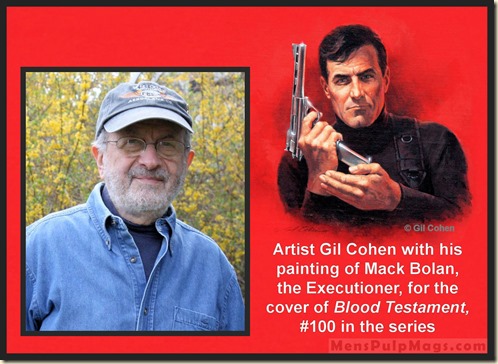
EDITOR’S NOTE: My previous post here was Part 1 of my extensive new interview with artist Gil Cohen about his cover paintings for the hugely popular Executioner/Mack Bolan series of novels created by author Don Pendleton. (In case you missed Part 1, click this link.)
If you’re a regular reader of this blog, you know that Gil Cohen is one of the top illustration artists who did artwork for both men’s action/adventure novels and men’s adventure magazines. In recent decades, he has become one of the premier military aviation artists in the world, creating paintings of airplanes and crews that are sold at fine art galleries and as high quality prints.
I first talked to Gil years ago, in an interview I did with him years ago about his men’s adventure magazine work. In that interview, he told me he sold almost all of his original MAM artwork in the 1970s.
Gil has also sold many of the nearly 200 cover paintings he did in the 1980s and 1990s for the Executioner books and the Mack Bolan spinoffs, the “Able Team” and “Phoenix Force” series. However, I found out recently that he had stored away about 60 of his favorites at his home in Buck’s County, Pennsylvania.
Now, at age 86, Gil is ready to sell his remaining Mack Bolan treasures.
I learned that from a notice placed in the great, long-running fanzine Paperback Parade by Gil’s representative Rich Greene, who does the Paperback Parade layouts.
Most of the Executioner cover paintings shown in this post and Part 1 of my interview with Gil are for sale.
If you see a painting you’d like to buy, contact Rich Greene via email at rlgreene@comcast.net, or call him at 856-278-4140.
Gil told me the prices he’s asking range from $1,000 to $2,500. He’s also willing to offers lay-away payments over time as an option.
Below is Part 2 of my recent interview with Gil, along with photos of more of the paintings he is selling and scans of the book covers…
* * * * * * * * * *
BOB DEIS: After you mentioned that it was Charles Kadin, the Art Director for the Harlequin Gold Eagle books, who asked you to do the cover paintings for Executioner series in 1981, I Googled Kadin’s name. I found out he was also an artist who specialized in military aviation art.
GIL COHEN: Indeed, he was. I first met him at that weird meeting I told you about, after he contacted me about doing the Executioner covers. I was surprised that he did. But the rest, as I’ve said, is history. During the years I was doing them, Charles and I sometimes got together in New York when I was doing reference photos shoots for my Mack Bolan cover art. Later, we both belonged to the Society of Illustrators in New York. They had what was called the Government Services Program, specifically an Air Force Art program and we both joined that.
We both joined the Air Force Art program. I think that was after I finished doing the Mack Bolan series. Charles did good artwork and I told him so. The last time I saw him was several years back. It was at a meeting of the American Society of Aviation Artists, which we had also both joined, at the Washington-Baltimore airport. Only a few months later he died. Anyway, if it wasn’t for Charles Kadin, I would have gone on to do two hundred Mack Bolan covers. Harlequin would have chosen someone else. But Charles wanted me.
Were the Executioner covers a major part of your income as an artist during the years you were doing them?
GIL: Not during the series’ Pinnacle period. Pinnacle asked me to take over covers for the series in 1972, so I did them for Pinnacle for nine years. The last one I did for Pinnacle was number 38, SATAN’S SABBATH. During the Pinnacle years, I was also doing a lot of work for a lot of different projects. For example, I was doing a lot of cover art for other Pinnacle paperbacks. A lot of work for Pinnacle. And I was still doing work for magazines. But after Charles Kadin hired me to do the Executioner covers and spinoffs for Harlequin, Harlequin was without doubt my most important client for over ten years. They were giving me so much work I hardly had the time to work for anybody else. I was doing one Mack Bolan every month. I was doing one Phoenix Force. And for several years I was also doing one Able Team cover every month.
That’s a hell of a lot of artwork. So, overwhelmingly, Harlequin was my main client from about 1981 until the early ‘90s. By the way, I heard that one of the Mack Bolan books I did a cover for, RETURN TO VIETNAM, was used by Sylvester Stallone as the basis for one of the RAMBO movies. In fact, as you may know, Stallone was an Executioner fan and wanted to be Mack Bolan in a movie, but for whatever reason he wasn’t able to.
Yes, that’s been a topic of discussion in the Mack Bolan Facebook group. Executioner creator Don Pendleton’s wife Linda Pendleton and some of the writers who wrote for the series hang out there. They confirmed that Stallone owned the movie rights the Executioner for a while and wanted to play Mack Bolan in a movie. It didn’t come together. But interestingly, Stallone used Executioner #43: RETURN TO VIETNAM, as part of the inspiration for the second Rambo movie, FIRST BLOOD PART II. The RETURN TO VIETNAM novel was written by action/adventure novelist Stephen Mertz and published in 1982. In that, Mack Bolan, who is a Vietnam veteran, goes back to ‘Nam on a mission to rescue an American P.O.W. who is still secretly being held there by the Vietnamese. Stallone’s second Rambo film came out in 1985. In it, Rambo goes to Vietnam to rescue American P.O.W.s who are still being secretly held there by the Vietnamese. By the way, looks to me like the media you used for Executioner cover paintings changed in the mid-80s. Did you start using oil paint instead of acrylics?
GIL: I’ll tell you when the oil painting began for the Executioner covers. It’s the one where Bolan has a kid with him and there’s fire in the background, a lot of warm colors.
That’s number 67, BEIRUT PAYBACK, published in 1984.
GIL: Yes. That’s the first one where I started using oil paints. It’s oil on canvas-covered illustration board. I had hardly ever used oil paints since I was an art student. Before that one I was using acrylics, and letting the paint be semi-transparent. Starting with BEIRUT PLAYBACK I began using oils and I felt as though I had really found my favorite new vehicle of expression. Before that I thought oil might look too loose. But I found I could tighten it up to the point I liked and then I loved painting in oils. After that, the majority of my paintings – Bolans, aviation art, or whatever it might be – the majority have been oil paintings.
Isn’t oil slower to work with?
GIL: Well, yes, traditionally it was. And that was one of the reasons I didn’t use oil previously, because of the drying time. But around the time I did BEIRUT PAYBACK I found out there were ways to speed up the drying. There’s a product called Liquin that was invented in the ‘70s. You add it to oil paint and it significantly hastens the drying. I also learned you could put a heat lamp on illustration paintings done with oil and Liquin, and that also helps speed up the drying. I would often have a heat lamp on a painting for a minimum of a few hours and sometimes overnight. And, in the morning it would usually be dry.
https://en.wikipedia.org/wiki/Liquin
Did you normally start with a pencil or charcoal sketch for your paintings?
GIL: Yes, I do sketches and reference photography and get my composition the way I want it. After I have a sketch that I like, I use tracing paper to do what I call a working drawing. You can see photos of how I do my process in my book GIL COHEN: AVIATION ARTIST. When I get the working drawing the way I want it, then I transfer that working drawing onto the canvas. I lay a sheet of graphite between the thin tracing paper and the canvas and go over the lines using a hard pencil. That’s really the most boring part of my work, transferring the drawing, because it’s fairly mindless. What it leaves is just and outline of what I need in the scene. Then I start with an underpainting, which is often acrylic.
Do many other magazine and book cover artists mix acrylics and oils?
GIL: Sure, it’s not unusual. But you don’t really mix them. Oil and water don’t mix. I’m sure you’ve heard that. You have to use the acrylic first. You use the oil last, over the acrylic underpainting. In fact, you can’t use acrylic, which is water based, over oil.
By the way, I forgot to ask when we were talking about the models you used for your Executioner covers. In addition to using your brother-in-law Robby Smith and some friends as models for Bolan, did you ever use yourself?
GIL: Yes, I did. I posed myself as Mack Bolan for the reference photos I used for some of the early Pinnacle covers and shot the photos with a Polaroid camera. For example, the first one I did for Pinnacle in 1971, CALIFORNIA HIT, I posed myself for that. Then they asked me to take over doing the covers for the series. I did twelve and thirteen and then Pinnacle asked me to do new cover paintings for new editions of the first ten in the series.
You used yourself for all those early ones?
GIL: Yes, from thirteen, WASHINGTON I.O.U. back, I largely used myself as the model for Mack Bolan and other male characters in the cover scenes. I could draw and turn myself into any kind of a character. And I did that a whole lot. As, I mentioned before, I didn’t use professional models for most of the illustration work I did, like a lot of other illustrators did. So, I posed for Executioner number eleven and twelve and then most of the ones I redid, including Number 1, WAR AGAINST THE MAFIA.
How did you take the reference photos of yourself?
GIL: I first tried using the timer on my Polaroid camera. But that didn’t work out very well. It was limited to ten seconds and I found I couldn’t get into position in ten seconds. Ten seconds go by very quickly. Then I decided a better way would be to attach a long cable to the shutter release of the camera, with a rubber bulb I would hold in my hand. When I was really ready I would squeeze the bulb and the camera would shoot the picture.
You told me that interesting story about making a model of the grenade launcher you made for the cover of Executioner number 60, SOLD FOR SLAUGHTER. What did you use as references for other guns?
GIL: I would usually get a replica of the gun and have the model I was using for the photo hold it. I rarely had the actual guns. So, I’d use a replica. I didn’t just depend on photos of guns because the handhold is a very important thing.
Meaning how the gun was held? So it would look realistic?
GIL: Yes. How the model was holding a gun was very important to me.
In addition to switching to oils, the overall style of your artwork for the Executioner covers seems to have evolved over the years.
GIL: Yes. My artwork got better during the Gold Eagle years. The art just got better. I don’t know if you see that.
I do. But I have to say I like them all and I know from reading fan forums about the Executioner books, the FB group, that many of the hard core Mack Bolan fans love your early ones best of all.
GIL: I know that and, believe me, I do respect I do respect my old work, especially considering the deadlines I was up against not only for the Mack Bolan covers but for the men’s adventure artwork I did that came before that. The magazines were especially tight deadlines. I’d be up all night to meet them. I could never do that today, nor would I want to today. I would be physically incapable of it today.
How did your selection of models for the Executioner covers change as your artwork changed?
GIL: For most of the early Executioner covers my models were friends or other attractive women I had known, and I would say “Would you mind posing for me?” Now, later, during the era when Harlequin’s Gold Eagle line started publishing the Mack Bolan novels, I had to be a bit more fussy about the female models. The people at Harlequin said, “Look, you get the right models in New York and have them shot at the studio our photographer uses there.” The painting I did for SOLD FOR SLAUGHTER in 1983 — one of my favorites by the way — is an example. That girl was a professional model who posed for that.
But you were still using your friends and brother-in-law for as your male models?
GIL: Yes, for example, in the SOLD FOR SLAUGHTER cover, done around 1983, my brother-in-law Robby Smith posed as Mack, as he did for many other covers. I bought him to New York to a photo studio of a photographer who specialized in doing reference photography for illustrators. Many illustrators used that photographer and I wouldn’t be surprised if many of the artists who came after me in doing Mack Bolan cover paintings used him. It was his specialty. When I needed models with a particular look, I would describe them to him or look at the photos of models in his photo book.
One young lady he had in his book looked perfect to pose as the Middle Eastern girl in the SOLD FOR SLAUGHTER cover. It’s funny that I remember this, but her last name was Cohen. Anyway, for a lot of the Gold Eagle years I used professional models for the women in the scenes. In the case of men, I either used my friends here in my own studio and did my own photography, or I would take them to New York with me.
In 1984, not long before the Mack Bolan Convention we discussed, Gold Eagle’s newsletter about the Executioner series — called AUTOMAG in honor of one of Mack Bolan’s favorite handguns – published the reference photo you used for SAVANNAH SWINGSAW. It’s an outdoor photo of a male model as Mack and a women together in a jeep. How often did you do outdoor photo sessions like that for your Executioner artwork?
GIL: I did outdoor shoots when it made sense because of what was in the scene. Or sometimes when I wanted a more natural look I would do it. For SAVANNAH SWINGSAW I couldn’t bring a jeep into the studio. So, I rented one and did the shoot outdoors. The model for Mack in that photo is my brother-in-law Robby Smith.
As I told you, I used him as Mack Bolan a lot, and in the SAVANNAH SWINGSAW cover painting you can see Mack has a certain resemblance to him. And, Robby had a build that was similar to Bolan. But as I also said, my Mack Bolan was also part Clint Eastwood, so I changed his face. And, Robby had blonde hair and blue eyes Now, if you look at the face of the Phoenix Force character Gary Manning in the cover paintings I did for that Executioner spin-off series, there was no change in the face. Manning’s face is Robby. I did some other outdoor shoots when I had a reason for it. There’s one where Bolan and a red-headed girl are both shooting and they’re in the woods. The photos for that one was shot outdoors.
That’s number 57, FLESH WOUNDS.
GIL: Yes, that’s it. I also shot the reference photos for nearly all of my later aviation paintings outdoors. I preferred shooting outside for those. For many of the scenes on the Bolan covers and for the romance covers I did for Harlequin books, there’s a certain theatricality. I wasn’t after a completely naturalistic effect and in many scenes I didn’t need things that I couldn’t bring inside. So, I preferred shooting indoors for those. But some of the Bolan reference photos were shot outside. And, to have the planes or right light, all of my aviation reference photos were shot outdoors, except for the painting “After the Mission.”
I love that one, with World War II bomber crew meeting in a Quonset style building, very dramatically lit. That reminds me – going back to that men’s adventure magazine painting of a World War II battle scene that you kept. After you emailed a photo of it to me, I found the story. It’s in MALE, December 1960. I’ll email a copy of the scan to you.
GIL: If I remember correctly, I was up against a tight deadline when I did that one, though after doing the men’s adventure art for some years at that point, I was no longer as scared of tight deadlines as I first was. I was more self-confident. I was self-confident enough to know I had finished enough to feel as though I could take the early part of the night off and go to a movie at a local drive-in. It was a new movie by Alfred Hitchcock that had gotten a lot of publicity, called PSYCHO. I remember thinking I had never seen anything like the shower scene. Of course, today, anything goes and everything goes. Anyway, I got back from the movie and it was past midnight, about 12:30, and I went right to the studio, right to my easel and I finished the painting overnight. I’d had the major part done, but the whole background had to be finished. And, I did the whole thing and delivered it the next morning.
It’s a great duotone illustration. When I looked closely at the two-page magazine spread it was used for I noticed something odd that I wanted to ask you about. In the magazine version, at the bottom left hand corner, there’s a guy climbing up the cliff. But he’s not there in the painting. It’s all cliff. Do you recall if you painted him out for some reason?
GIL: That’s interesting! No, I haven’t a clue about that! I’d never noticed the difference. It’s possible that when I delivered the painting the editors asked me to add that partial figure and later when the painting was returned to me I painted it out. But after 58 years I cannot remember!
Another thing I noticed about that one and other artwork you were doing for men’s adventure magazines is that it’s clearly your own style. A lot of the cover and interior illustrations other artists did for men’s adventure magazines the ‘50s and ‘60s had a very smooth, very realistic look. They were often sort of men’s adventure versions of Norman Rockwell realism. Your style was looser and more “arty,” more…
GIL: Painterly.
Yes. That’s the word. More painterly, less hyperrealistic, with more visible brushwork. It’s a very recognizable style.
GIL: I appreciate that you recognize my style in those illustrations. In fact, regardless of the genre I did, and although my media and approach did change over time, I do have a recognizable style in my work. Not only in my painting technique, but also in composition. There’s a certain way I compose pictures. And, I think I still do it that way today, even in the aviation art I paint now. I always wanted to keep my work painterly, though sometimes, toward the end of my Mack Bolan period, some of those cover paintings got smoother. I use the word tighter. They got tighter. And that was fine for what was needed and popular at the time, so that was OK.
When I started doing aviation art for galleries and commissions years later, I wanted to get back to a more painterly style. So, I did, though I knew I couldn’t let it be too loose and painterly for an audience that likes paintings of planes and crews. That audience expects a certain amount of realism. But if you look at my original aviation artwork up close, you going to see a lot of brush strokes. If you back up a little bit, they begin to disappear. But when you get fairly close, you see the brush strokes and I don’t want to hide them. I don’t try to hide them. Because part of the energy that goes into my artwork is in those brush strokes. There’s an energy I want to see and be seen in those brush strokes. If I smooth them over too much, to me it dissipates the energy. I’m not talking about any other artist. I’m just talking about myself.
I think you were kind of on the cutting edge of a change that happened in MAM art in the early ‘60s. The ‘50s art was mostly Norman Rockwell style realism. In the 60s, more modern, more graphic arts like styles became common.
GIL: Yeah, I think so, though I wasn’t all that conscious of it at the time. It just evolved. But whatever I did from the time I became a professional artist, which really goes back to 1953, right up to today, I am a lucky person, Bob, in that, no one ever got terribly rich as an illustration artist, but I enjoyed most- of what I did.
That’s sounds like a definition of success, to me.
GIL: It may be. And, you know, in more recent years, in the age of the internet, I have found out that some of my work has affected people and their lives in some way. And, I think, “Wow, that’s OK. It really is.” I don’t know how long I’m going to be living. I sure feel healthy now. More so than most 86-year-olds I think. And, I’ve enjoyed what I did. So, I’m lucky.
* * * * * * * * * *
Comments? Corrections? Post them on the Weasels Ripped My Book Facebook Page, email them to me,
or join the Men’s Adventure Magazines & Books Facebook Group and post them there.
* * * * * * * * * *
Related reading…


